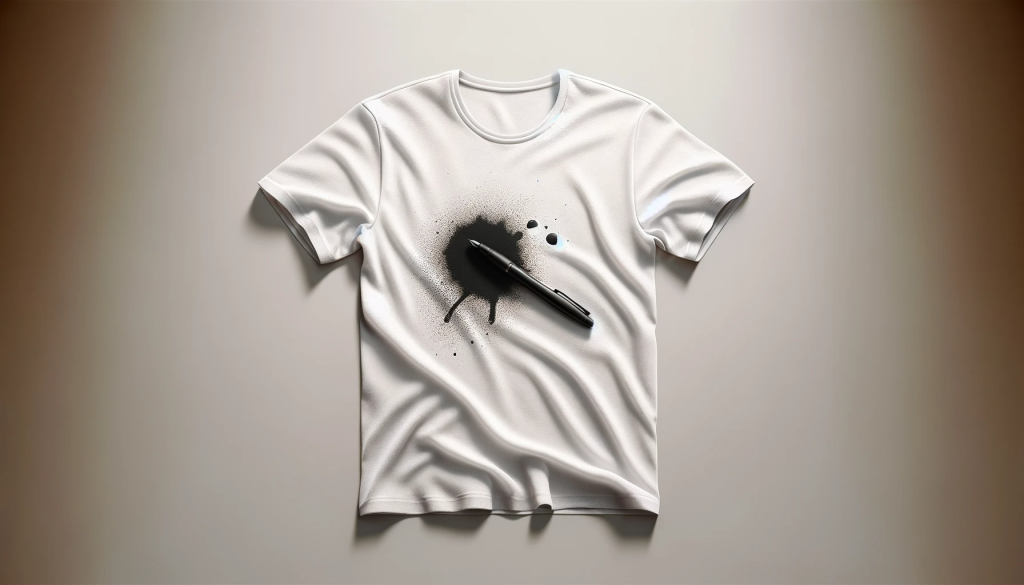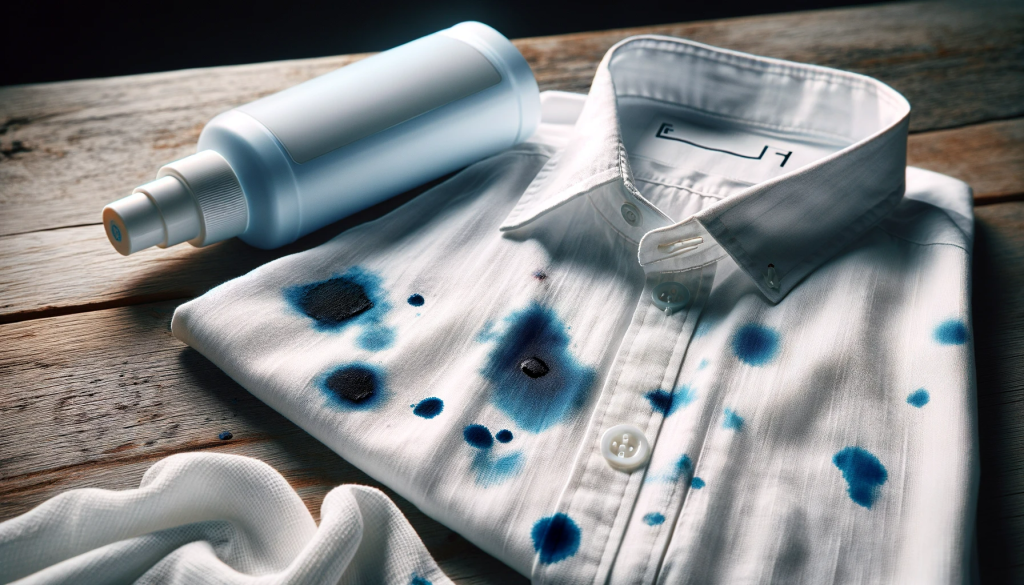Whether it’s a favorite blouse or a cherished pair of jeans, ink stains don’t have to mean the end of the road for your beloved garments. With the right techniques and a bit of patience, you can restore your clothes to their former glory. For more tips on preserving your wardrobe, visit InktasticMerch and explore a world of ink-friendly fashion solutions.
Realizing your go-to shirt has an ink stain can feel catastrophic. Did you know that just one pen accident might spoil an entire load of laundry? This guide will walk you through a detailed process to eradicate ink stains from your clothes, breathing new life into them.
Continue reading – it’s easier than you might expect!
Key Takeaways
- Address ink stains immediately, as prompt action boosts the likelihood of complete removal. Gently blot any excess ink with a clean cloth or paper towel to hinder further spreading.
- Determine whether the ink is water-based or oil-based, as this will shape your cleaning strategy. Use soap and warm water for water-based stains, while oil-based marks are best tackled with rubbing alcohol or hand sanitizer.
- Always test your selected cleaning method on a hidden part of the fabric to ensure it doesn’t get damaged.
- Each fabric needs specific care: apply glycerin for wool, alcohol for cotton and jeans, mild soap for leather, and softly blot velvet with lukewarm soapy water.
- If stubborn stains resist home remedies, try a milk or vinegar and cornstarch paste mixture. Should these approaches not succeed, consider professional cleaning services for robust solutions tailored to particular fabrics and ink types.
Understanding Different Types of Ink Stains

Different types of ink stains present distinct challenges, ranging from water-based drawings to stubborn oil-based blots. Identifying the ink’s nature is essential in devising the best plan to save your cherished clothing items from lasting marks.
Water-based vs. Oil-based
Water-based ink stains are generally easier to remove since they dissolve in water, making them less daunting to deal with. Often, soap and warm water are sufficient to lift these stains from fabrics.
The removal of water-based ink typically involves gentle techniques that protect delicate fabrics from damage.
Conversely, oil-based ink stains require more effort due to their stubbornness and refusal to mix with water, clinging resolutely to clothing fibers. Dealing with ballpoint ink often involves handling oil-based marks; employing hand sanitizer or rubbing alcohol can effectively break down the oils, ensuring the stain disappears without a trace.
Ballpoint Pen, Felt-tip Pen, Permanent Marker
Focusing on common culprits, let’s explore stains from ballpoint pens, felt-tip pens, and permanent markers, each posing unique challenges to your stain-removal techniques.
Ballpoint pen ink is typically oil-based, which makes it particularly resistant. Dissolving the oils with rubbing alcohol or nail polish remover helps release the color from clothing.
Felt-tip pens and permanent markers bring their own difficulties. While felt-tip inks are often water-soluble, some compounds may cause them to stick to fibers stubbornly. Rubbing alcohol, sometimes combined with vinegar, can effectively tackle the dyes and pigments these pens can leave.
Meanwhile, the resilient solvents and resins in permanent markers strongly bind to fabric. Home solutions like aerosol hairspray or hand sanitizers containing alcohol can help disrupt these bonds, facilitating stain removal.
allowing the bulk of the mark to be lifted away, with thorough laundering ensuring any lingering traces are completely removed.
General Tips for Removing Ink Stains

Speed is vital when dealing with ink stains; swiftly blot the excess ink to halt its spread. Select a cleaning solution tailored to the specific ink type—every stain has an optimal remover.
Blotting Excess Ink
Start by lightly pressing a clean cloth or a paper towel over the ink stain. Avoid rubbing, as this only spreads the ink further, worsening the stain. Keep dabbing with fresh parts of your cloth to absorb as much ink as you can.
Quick action is necessary because once the ink sets, removal becomes more difficult.
Regularly change your blotting material, ensuring you’re not reapplying ink to the fabric. If there is a lot of excess liquid, place a layer beneath the garment to protect other materials from contamination.
This step is crucial and sets the stage for the stain removal process that follows.
Using Appropriate Cleaning Agents
Selecting the right cleaning agent is essential for efficiently removing ink stains. For water-based inks, a simple solution of liquid dish soap mixed with warm water often works effectively.
Gently rub this concoction into the stain using a soft cloth or sponge before thoroughly rinsing. For oil-based inks, opt for an alcohol-based product like hairspray or hand sanitizer.
Apply directly to the stain, allowing a few minutes for the ink to dissolve.
Before applying any cleaning agent, test it on a discreet fabric section to ensure no damage or discoloration. After treatment, wash your clothes as usual with a laundry detergent that suits the fabric.
For delicate or bright fabrics, choose detergents labeled as “gentle” or “color-safe” to protect the fabric while efficiently removing the stain.
How to Remove Ink Stains from Different Types of Fabric

Eliminating ink stains from clothing requires a method suited to the fabric type. Discover effective techniques for saving your beloved items from ink mishaps, whether it’s a favorite cotton tee or a prized leather jacket.
Cotton
Ink stains on cotton can be a nuisance, whether due to an accidental pen stroke or a burst marker, but quick action is key to their removal.
- Immediately dab the stain with a clean cloth to absorb excess ink.
- Position the garment flat, placing the stained side down on a paper towel.
- Apply rubbing alcohol or hand sanitizer on the underside, letting it permeate through to the paper towel.
- Keep moving to clean sections of the towel as the ink transfers from the cotton.
item.
Jeans
A must-have in any wardrobe, jeans are unfortunately not safe from ink stains. Here’s a guide to tackling ink on denim:
- Swift attention to ink stains on jeans can improve the odds of successful removal.
- Place the stained jeans on a flat surface with a clean white cloth beneath the stain to prevent ink from spreading.
- Carefully blot excess ink away with a paper towel rather than rubbing, which can worsen the stain.
- Directly apply rubbing alcohol or hand sanitizer to the stain, as these effectively dissolve oil-based inks.
- Use an old toothbrush or cotton swab to gently work the solution into the stain, starting at the edges and moving inward in circular motions.
- Rinse with cold water to help lift additional ink from the fabric.
- If the stain lingers, mix two parts vinegar with three parts cornstarch to form a paste. Spread this over the area and let it sit for a few hours before laundering.
- Wash your jeans in cold water with laundry detergent, alone, to avoid setting the ink in the fabric fibers.
- Inspect them post-wash, and only dry if the stain is gone—heat may set the stain permanently otherwise.
Wool
Ink stains on wool require gentle handling due to the delicate nature of the fibers. Here’s how to clean them carefully:
- Promptly address ink stains on wool, as its absorbent nature can trap ink quickly.
- Use a clean, dry cloth to gently blot excess ink from the stain, avoiding rubbing to prevent spreading.
- Apply a bit of glycerin to soften the ink, letting it sit for several minutes.
- Rinse off the glycerin with cold water, as hot water risks setting the stain deeper.
- Prepare a mild liquid detergent solution mixed with cool water. Dab it onto the ink using a soft cloth or sponge.
- Continue blotting until the cloth or sponge no longer picks up ink.
- If stubborn, apply a small amount of rubbing alcohol, which can dissolve oil-based ink without damaging wool.
- Thoroughly rinse all solutions with cool water to eliminate residue.
- Place the wool garment flat on a towel, rolling it up to squeeze out moisture without wringing, to avoid reshaping the wool.
- Allow it to air dry naturally, away from direct heat or sunlight, which could cause shrinking or fading.
Leather
Ink stain removal from leather requires precision, given its fragile nature and porous surface. Acting fast is vital to avoid the ink setting in.
- Use a clean, dry cloth to gently blot the ink-stained area to absorb as much ink as possible. Rubbing can cause spread, so avoid it.
- Apply a small amount of rubbing alcohol or non-acetone nail polish remover to a cotton ball, testing it first on a hidden leather spot to check for any possible damage.
- Carefully dab the stained area with the cotton ball.ball, beginning at the stain’s outer edges, to gradually lift off the ink. Replace the cotton balls with fresh, alcohol-soaked ones as required.
- If any residue remains, mix mild liquid soap with water and lightly apply with a soft cloth or sponge. Rinse the area by wiping it with another damp cloth, taking care not to soak the leather.
- Pat down any wet spots with a clean towel until slightly damp. Allow it to air dry naturally, avoiding direct heat sources or sunlight that can harm leather.
- Once dry, condition your leather with an appropriate leather conditioner to restore moisture and protect it from future stains.
Velvet
Moving from the sturdiness of leather to the refined texture of velvet, ink stain removal requires a gentle approach. Velvet’s luxurious surface can be tricky to clean, yet with delicate care, its original allure can be revived.
- Quickly address ink stains on velvet by gently dabbing the area with a clean, dry cloth to absorb excess ink without spreading it further.
- Conduct a patch test of your chosen cleaning solution on a discreet part of the fabric to ensure it won’t harm the color or texture.
- Prepare a solution of lukewarm water and mild liquid soap. Stir carefully to avoid excessive suds.
- Immerse a soft sponge in the soapy mixture, wring it out to ensure it’s lightly damp, and then softly blot the stain. Avoid excessive rubbing to preserve velvet’s nap.
- After blotting with the soapy water, use a fresh dry cloth to soak up any lingering moisture.
- If soap alone is insufficient, try applying a small amount of white vinegar with a cotton swab.
- Let the fabric air dry completely before using or wearing, steering clear of heat as it can compress velvet’s pile.
- If the stain remains post-drying, consider consulting professional cleaners who specialize in delicate fabrics.
Additional Tips for Stubborn Ink Stains

Sometimes, ink stains persist despite initial attempts at removal. In such cases, a few more strategies might help lift those stubborn spots from your treasured clothes.
Using Rubbing Alcohol
Rubbing alcohol proves effective for removing ink stains, particularly from cotton and denim. Pour a small amount onto the stain and gently dab with a clean cloth to dissolve the ink.
Avoid vigorous scrubbing, which can spread the stain or damage fragile fabrics. Let it sit for several minutes to allow the alcohol to penetrate the fibers.
After applying rubbing alcohol, wash your clothing with detergent as normal. This aids in removing any residue left by the ink and alcohol.
Perform this shortly after applying the alcohol for the best chance of successfully removing stubborn ink stains from clothes.
Milk or Vinegar and Cornstarch Paste
Facing a stubborn ink stain on your favorite garment can be challenging, but your kitchen holds a surprisingly effective remedy. Mix milk or vinegar with cornstarch to form a thick paste.
Carefully apply this mixture to the stained area of your clothing and let it sit for several hours. The proteins in the milk or the aceticThe acid in vinegar helps dissolve the ink, while cornstarch acts to lift it from the fabric.
After allowing the paste sufficient time to work its magic, brush off the residue before placing the garment in the washing machine. Proceed with a regular wash using a detergent known for tackling ink stains, and voilà! You may witness that pesky blotch fade, leaving your attire pristine and ready for another day.
Keep this tactic handy for future mishaps when a pen decides to leak havoc on your clothes—it might just spare them from being demoted to rags.
Seeking Professional Cleaning Services if Necessary
If your home remedies like milk, vinegar, and cornstarch aren’t producing results, it might be wise to consider professional cleaning services. They have the expertise and equipment to handle stubborn ink stains resistant to DIY treatment.
Professionals know how to manage various fabrics delicately, ensuring no harm comes to sensitive materials like velvet or silk, where ink stain removal is particularly tricky.
Don’t shy away from seeking professional assistance for those persistent stains; specialists are adept at eradicating ink from a wide range of garments, bringing them back to their former glory.
Turning to a professional service can also save time and prevent costly errors. If you’ve exhausted every laundry hack with no success, it’s time to rely on those who are experts in stain removal.
They employ advanced methods and commercial-grade products tailored for challenging tasks, such as eliminating ballpoint ink or stubborn marks on both whites and colored fabrics.
Conclusion
Banishing ink stains from your beloved clothes doesn’t have to be a headache. With the appropriate tools and strategies, any ink mishap can be addressed effectively. From fresh to dated, ballpoint to permanent marker, there’s a remedy for every fabric type.
Remember to stay committed and patient, as certain stains might need multiple treatments. Adopt these techniques and make ink stain removal a part of your laundry skill set!
FAQs
1. What’s the first step to take when I get ink on my clothes?
Upon noticing the ink stain, gently blot it with a clean cloth or paper towel, avoiding any rubbing into the fabric.
2. Can hairspray help remove an ink stain from clothes?
Indeed, hairspray with a high alcohol content can assist in breaking down the ink prior to washing.
3. Is it possible to get old ink stains out of clothes?
While challenging, pre-treating old stains with specialized removers followed by laundering can be effective.
4. Will rubbing alcohol damage my clothes if I use it to remove an ink stain?
Rubbing alcohol is generally safe for most fabrics, but it’s prudent to test it on a small hidden area first.
5. Can all types of fabric handle the same methods for removing ink stains?
No, delicate materials like silk or wool require special care and specific instructions for stain removal.
For more insightful tips and tricks on tackling various fabric challenges, explore our Blog for a wealth of practical advice and solutions.




